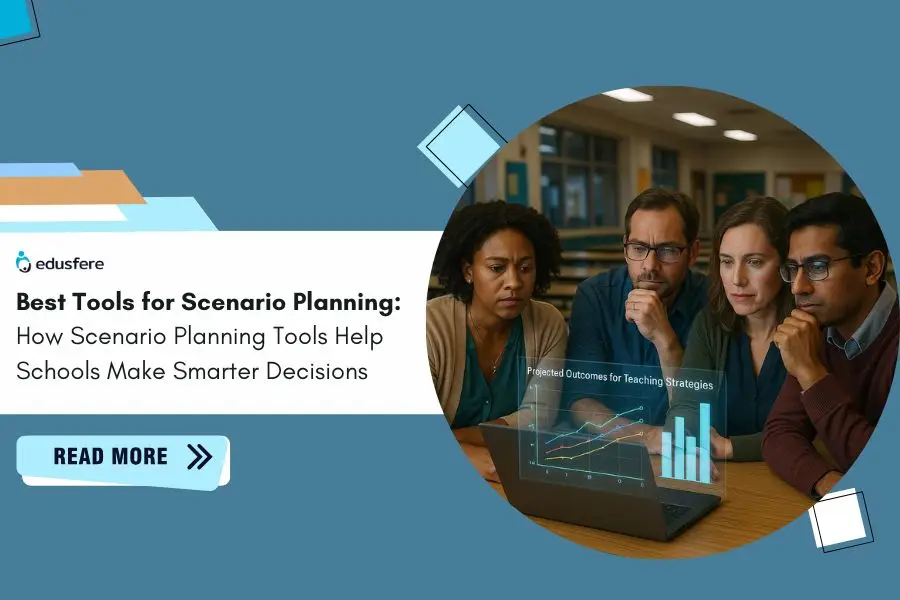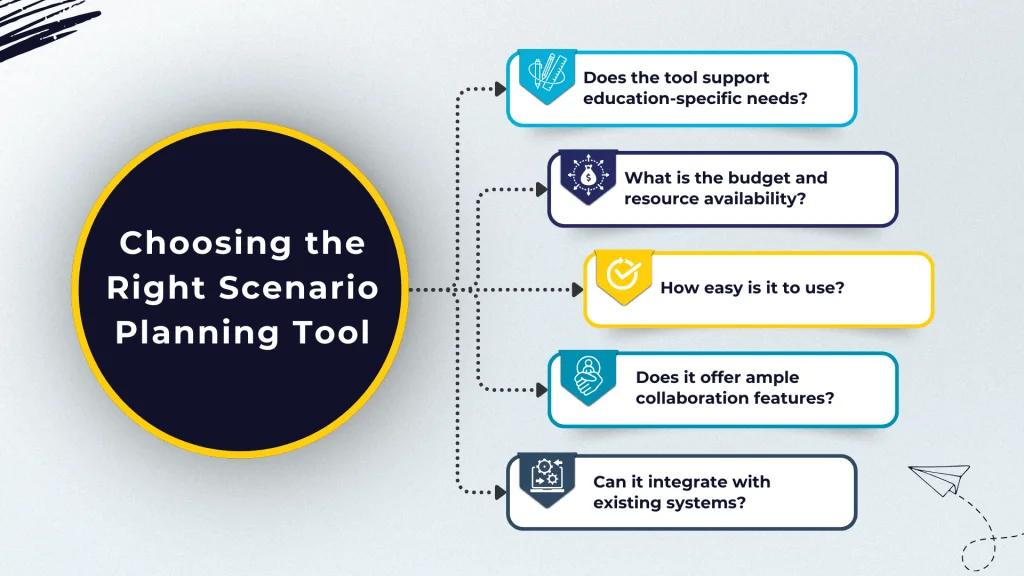Schedule a free demo to learn more
Best Tools for Scenario Planning: How Scenario Planning Tools Help Schools Make Smarter Decisions
29th Aug 2025

What are Scenario Planning tools in education?
In education, scenario planning tools are digital platforms or software designed to help schools prepare for different possible futures. They allow administrators, teachers and district leaders to model what if situations such as enrollment shifts, funding changes or curriculum adjustments and assess the potential outcomes.
Instead of making decisions based only on guesswork, schools can use these tools for scenario planning to visualize multiple possibilities and choose strategies that are most resilient.
For example, a district might use scenario planning software to explore:
- What happens if enrollment declines by 10% in the next five years?
- How should the school allocate resources if government funding drops?
- What curriculum changes will better prepare students for future workforce needs?
By simulating such possibilities, scenario planning tools give schools a data-driven approach to decision-making.
Why do schools need tools for Scenario Planning?
Educational institutions face constant uncertainty, ranging from policy reforms and budget cuts to technological disruption and global challenges like pandemics. Without structured planning, schools risk being reactive instead of proactive.
Here are the top reasons schools need scenario planning tools today:
1. Rising Complexity in Education Systems
Schools are managing more than just classrooms. They oversee budgets, teacher staffing, infrastructure, technology adoption and student performance data. Scenario planning tools simplify these complexities by offering structured, visual insights.
2. Preparing for Enrollment Fluctuations
Student enrollment directly impacts funding and staffing. Tools for scenario planning help schools simulate enrollment growth or decline and prepare accordingly.
3. Adapting to Policy and Curriculum Changes
Education policies shift frequently. With scenario planning software, administrators can model how new policies affect curriculum delivery, teacher workloads or student learning outcomes.
4. Aligning Resources with Long-term Goals
From technology investments to teacher development programs, schools need to ensure resources are used effectively. Scenario planning tools provide the foresight to make smarter, future-proof decisions.
5. Managing Crisis and Uncertainty
The COVID-19 pandemic highlighted how unprepared many institutions were for sudden disruptions. Schools that had engaged in scenario planning were quicker to adapt to remote learning and funding reallocations.
What are the best Scenario Planning Tools for Schools?
There is no shortage of scenario planning tools available, but schools need platforms tailored to budgeting, curriculum planning, and long-term strategy. Below are some of the top free and paid tools for scenario planning:
1. Edusfere (Best for curriculum-centered Scenario Planning)
What it does: Focuses on curriculum mapping and management while also enabling schools to plan different future scenarios around student learning, curriculum compliance and accreditation readiness.
Best for: K-12 schools that want curriculum-integrated scenario planning.
Why it stands out: Unlike generic business tools, Edusfere is designed specifically for schools. It allows administrators to simulate curriculum shifts, accreditation requirements and real-time resource allocation.
2. Microsoft Excel + Power BI (Free with Office 365)
What it does: Offers customizable spreadsheets and data dashboards for scenario modeling.
Best for: Schools with budget constraints or those already using Office 365.
Why it stands out: Highly flexible and widely used, though it requires manual setup and lacks education-specific templates.
3. Tableau (Best for Data Visualization in Scenario Planning)
What it does: Helps schools create interactive visualizations of multiple scenarios.
Best for: District-level decision-makers who want to analyze large amounts of data (e.g., enrollment trends, test scores, budget distribution).
Why it stands out: Powerful visualization capabilities, though it requires training for educators unfamiliar with data analytics.
4. AnyLogic (Advanced Simulation Tool)
What it does: Provides sophisticated simulation modeling used in business, healthcare and increasingly in education.
Best for: Universities and large districts that want complex simulations (e.g., pandemic response, campus resource allocation).
Why it stands out: Extremely versatile but has a steep learning curve.
5. Scenari-Aid (Free Educational Planning Tool)
What it does: A lightweight, open-source tool designed for scenario training and decision-making.
Best for: Schools wanting a no-cost introduction to scenario planning.
Why it stands out: Simple to use, though less robust compared to enterprise-grade tools.
6. Oracle Hyperion (Enterprise-level Planning)
What it does: A corporate-grade planning and forecasting tool that can be adapted for large educational systems.
Best for: State-level education departments or very large school districts.
Why it stands out: Offers enterprise power, but may be excessive for smaller schools.
How Can Schools Choose the Right Scenario Planning Tool?

With so many tools for scenario planning, schools need to select the one that matches their size, resources and goals. Here are the criteria to consider:
1. Does the tool support education-specific needs?
Generic scenario planning tools may not include features like curriculum mapping, accreditation readiness or compliance tracking. Schools should look for platforms that directly address these needs.
2. What is the budget and resource availability?
- Low-cost/free tools: Excel, Google Sheets, Scenari-Aid
- Mid-range tools: Edusfere, Tableau
- High-cost/enterprise tools: Oracle Hyperion, AnyLogic
3. How easy is it to use?
Teachers and administrators may not be tech experts. The best tools should have user-friendly dashboards, templates and built-in integrations.
4. Does it offer collaboration features?
Scenario planning is not a one-person job. Look for tools that enable multiple stakeholders including teachers, principals and administrators to collaborate in real time.
5. Can it integrate with existing systems?
If your school already uses LMS platforms (Google Classroom, Canvas) or student information systems, integration is essential for seamless adoption.
How Do Scenario Planning Tools Support Curriculum Integration?
A common concern schools have is whether scenario planning tools fit into their existing curriculum processes. The answer: yes, when chosen wisely. Here’s how scenario planning tools support curriculum integration:
Curriculum Mapping: Align curriculum plans with different future scenarios (e.g., online learning expansion, STEM adoption).
Teacher Planning: Provide teachers with data-driven insights on potential changes in class sizes, schedules or resources.
Student Outcomes: Ensure that changes in curriculum still align with long-term student success goals.
Accreditation Readiness: Map curriculum requirements against different accreditation pathways.
The Edusfere Advantage
One powerful feature of Edusfere is that schools can build courses without immediately assigning them to teachers. This means administrators can create a library of courses that remain ‘on hold’ for different scenarios; each with its own approach, template and structure. This flexibility allows schools to stay proactive rather than scrambling when changes occur.
FAQs about Scenario Planning Tools in Education
1. What are the most commonly used tools for scenario planning in schools?
Excel, Edusfere and Tableau are among the most popular due to their balance of affordability and usability.
2. Are scenario planning tools only for administrators?
No. While administrators lead the process, teachers and curriculum planners can use these tools to adapt lesson plans and resources to future scenarios.
3. Can small schools benefit from scenario planning tools?
Yes. Even small schools with limited budgets can use free or low-cost scenario planning tools like Excel or Scenari-Aid.
4. Do scenario planning tools require technical expertise?
Some do (e.g., AnyLogic, Tableau), but education-focused platforms like Edusfere are designed for non-technical users.
5. How often should schools update their scenarios?
Ideally, once a year at minimum. However, schools should also revisit scenarios whenever major changes occur such as new policies, funding adjustments or enrollment shifts.
Why Scenario Planning tools are a must for schools in 2025
To thrive in a rapidly evolving world, schools cannot afford to operate reactively. Scenario planning tools give educators and administrators a structured way to anticipate challenges, allocate resources smartly and design resilient curriculum strategies.
Whether a school chooses a lightweight tool like Excel or a specialized platform like Edusfere, the key is to adopt scenario planning as a regular practice, not a one-time activity. By doing so, schools make smarter decisions, prepare for uncertainty and secure better outcomes for students.
Looking for a curriculum-integrated scenario planning solution? Explore how Edusfere can help your school stay future-ready with real-time scenario modeling and curriculum mapping.